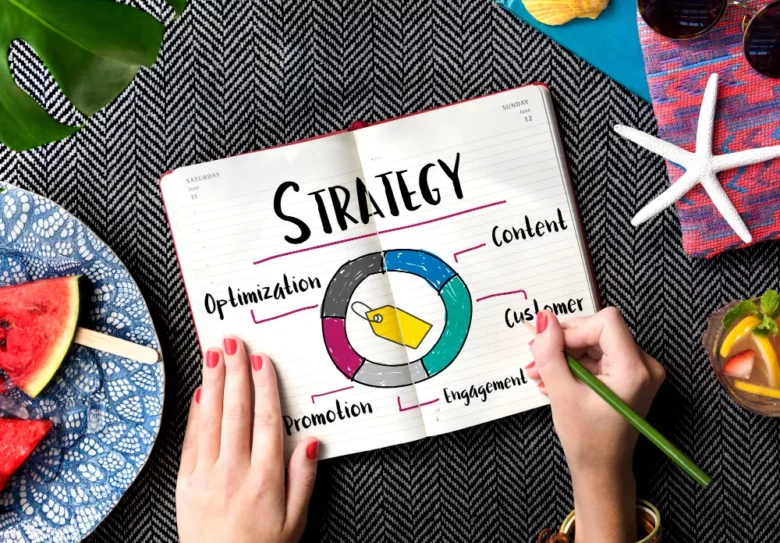What is a Content Strategy?
A content strategy is a blueprint for producing, sharing, and managing content to achieve specific business goals and objectives. It involves conducting research, identifying your target audience, selecting the most effective content formats, and deciding how and where to disseminate that content.
- Why Content Strategy matters?
- What are the Main Components of a Content Strategy?
- Steps to Build an Effective Content Strategy
- How do links & CTA play a role in setting up a Content Strategy?
- To Conclude
Why Content Strategy matters?
- A good content strategy ensures that your content is in line with your overall business goals and is reaching the right audience.
- It also helps you to avoid wasting resources by creating content that doesn’t achieve your desired results.
- Additionally, a good strategy can help you build a strong and consistent brand, increase website traffic and engagement, and generate leads and conversions
This is a critical aspect of any successful marketing campaign. This article outlines the components of a content strategy and the steps to build one, boost your existing marketing strategies and improve results.
What are the Main Components of a Content Strategy?
A successful strategy focuses on creating a clear and detailed outline of all the information that your company needs to convey to its customers, stakeholders, and partners. A content strategy should include the following components:
- Goals and Objectives: outlining what the organization hopes to achieve with its content.
- Audience Identification: Identifying the target audience for the content.
- Content Themes: Identify the topics and themes that the organization will cover in its content.
- Content Types: Identify the different types of content that will be created (e.g. blog posts, videos, infographics, etc.).
- Content Distribution: Identifying the channels through which the content will be distributed (e.g. website, social media, email, etc.).
Pro Tip: You can make use of shortlinks and social cards to present the content across multiple channels – this makes you present the content better and crisper. - Metrics and Analysis: Identify the metrics that will be used to measure the success of the content and how it will be analyzed.
- Governance: Identifying the process, roles, and responsibilities for creating, publishing, and maintaining the content.
- Maintenance: Having a plan for updating and repurposing content over time.
Steps to Build an Effective Content Strategy
As we enter a new year, many businesses are looking to refresh and revamp their strategy to stay competitive and relevant in the ever-evolving digital landscape. Here are a few tips to help you set up in 2023:
- Understand your Target Audience: The first step in developing a content strategy is understanding your target audience. By understanding your audience, you can create content that speaks directly to them and addresses their needs. This includes identifying their demographics, interests, pain points, and behaviours.
- Define your Goals: What do you want to achieve with your content? Your goals should align with your overall business objectives, such as increasing brand awareness, driving website traffic, or generating leads.
- Determine the Types of Content you will Produce: There are many different types of content to choose from, including blog posts, videos, infographics, e-books, and more. It’s important to select the types of content that will resonate with your target audience and help you achieve your goals.
- Create a Content Calendar: A content calendar helps you plan and organize your content in advance. This allows you to ensure that you have a steady stream of fresh, relevant content to share with your audience regularly.
- Measure and Optimize: What gets measured, gets managed. It’s important to track the performance of your content and make adjustments as needed. You can make use of analytics tools to measure the engagement, reach, and conversions of your content, and use this data to optimize your strategy for better results. Learn how to add UTM parameters to a link, to measure and analyze marketing metrics.
- Be Adaptable: Gone are the days when people used to read lengthy articles. With the digital landscape constantly changing, it becomes imperative to craft your content strategy accordingly to ensure that your work achieves the intended outcomes. Keep an eye on new trends, technologies, and platforms and make updates as needed. Also, make your content smart and presentable with clickable Social Cards from Socxly.
By following these steps, you can set up a content strategy that is tailored to your audience and goals, and that helps you stay competitive in the ever-changing digital landscape.
How do links & CTA play a role in setting up a Content Strategy?
Along with good content, links and CTAs have a great deal in setting up a content strategy. A crisp and captivating CTA, coupled with meaningful, custom short-link will grab views at the first instance itself. Thus, a marketer needs to give due attention to these 2 elements while crafting the content, to ensure that the content/the marketing campaign is loaded to the teeth.
With Socxly, you can create multiple short links for the content that can be repurposed, add Call to Action banners to your content, and create Social Cards that attract readers in the first instance. To explore further what all Socxly can offer click here.
To Conclude
Content strategies are based on the idea that content can be categorized and can be used for different purposes. This makes it easier for your consumers to find the right information they need at any time or moment in time. You can then build your content strategy around the goals you want to accomplish, drive traffic and generate leads.
It is also necessary to make sure that your content is created in different formats and delivered to multiple distribution channels. With this guide, you should now be able to develop a successful content strategy for 2023.




